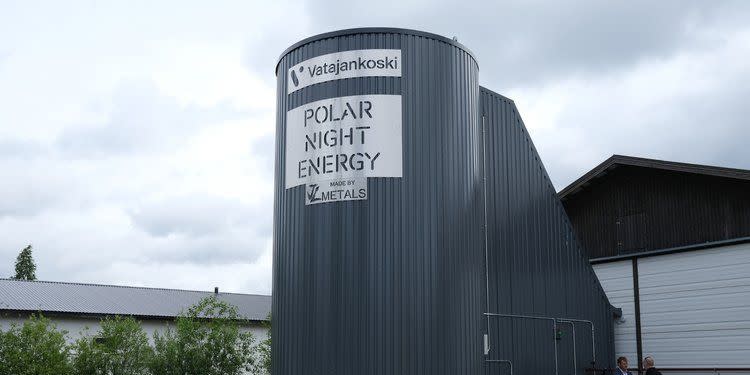This Massive ‘Sand Battery’ Can Store Excess Solar and Wind Energy for Months

The world’s first sand battery acts as a high-capacity reservoir for excess wind and solar energy.
Energy is stored as heat, which can then be transferred for commercial use.
Currently, the battery is helping heat a small town in western Finland.
The community swimming pool in the Finnish town of Kankaanpää is heated with sand—well, a sand battery, to be more specific.
Energy utility Vatajankoski has partnered with Polar Night Energy, a seasonal heat storage company, to store excess energy from local wind and solar farms as heat inside the world’s first commercial sand battery. From there, the sand battery can transfer that heat to towns for use in homes, industry, and community pools.
🔋 Join Pop Mech Pro for more turbocharged energy stories.
“Its main purpose is to work as a high-power and high-capacity reservoir for excess wind and solar energy,” Markku Ylönen, Polar Nigh Energy’s co-founder and CTO, says in a statement. “The energy is stored as heat, which can be used to heat homes, or to provide hot steam and high temperature process heat to industries that are often fossil-fuel dependent.”
While Ylönen admits the concept of heating sand to store energy isn’t entirely new, he says their way of commercializing it in a large-scale application is. The first installation in western Finland features an insulated silo made of a 23-foot-tall steel housing, filled with 110 tons of sand and heat transfer pipes. Electricity from the grid or local production—in both cases from fluctuating sources—allows Polar Night Energy to charge the sand when clean electricity is more cheaply available, typically during the middle of the night. The electrical energy is transferred to the heat storage using a closed loop air-pipe arrangement.
Sand—a high-density, low-cost material that the construction industry discards—is a solid material that can heat to well above the boiling point of water, and that can store several times the amount of energy of a water tank. The Kankaanpää unit can reach 600 degrees Celsius; The maximum temperature of sand-based heat storage is not limited by the properties of the sand, but by the heat resistance of the materials used in the construction and control of the storage, Ylönen says.
The sand doesn’t store electricity, but stores energy in the form of heat. To mine the heat from storage, cool air blows through pipes, heating up as it passes through the unit. It can then be used for a variety of tasks, including converting water into process steam or heating water in an air-to-water heat exchanger. The heat can also be converted back to electricity, albeit with electricity losses, if the application includes turbine technology.
Ville Kivioja, lead scientist at Polar Night Energy, tells the BBC that the Finnish battery stores 8 megawatt hours of thermal energy when full, and discharges about 200 kilowatts of power through the pipes, enough for 100 homes and the public pool. “There’s no wear and tear involved with the [heat exchange] pipes and the sand,” he says. “The fan is the only moving part and it’s easy to replace, if necessary.”
More Energy Stories We Love:
These Electricity-Producing Zombie Bacteria May Power Your Wearables in the Future
As Tokamaks Get Hotter, Scientists Must Control the Unruly Plasma Inside
Detractors of the sand battery concept say the sand stores up to ten times less energy per unit volume than a traditional chemical battery, according to the BBC, but Polar Night Energy says its battery is up to ten times cheaper than a lithium battery storing the same amount of energy. Tomi Eronen, CEO, tells the BBC the Kankaanpää sand battery costs about $200,000, while a lithium-ion battery storing the same amount of energy would be at least $1.6 million.
The company says sand battery projects are scalable up to 1,000 megawatt hours.
While Ylönen says the sand can stay hot for months, the current Kankaanpää process heats the sand in two-week cycles. “The heat storage has its best range of use when it is charged and discharged 20 to 200 times per year,” he says, “depending on the application.”
And as the company uses the sand, it grows denser, requiring less space.
“We are completely overwhelmed by the positive—and massive—attention we have been getting,” Ylönen says. “We will be doing our best to get our innovation to as many places as possible.”
You Might Also Like
